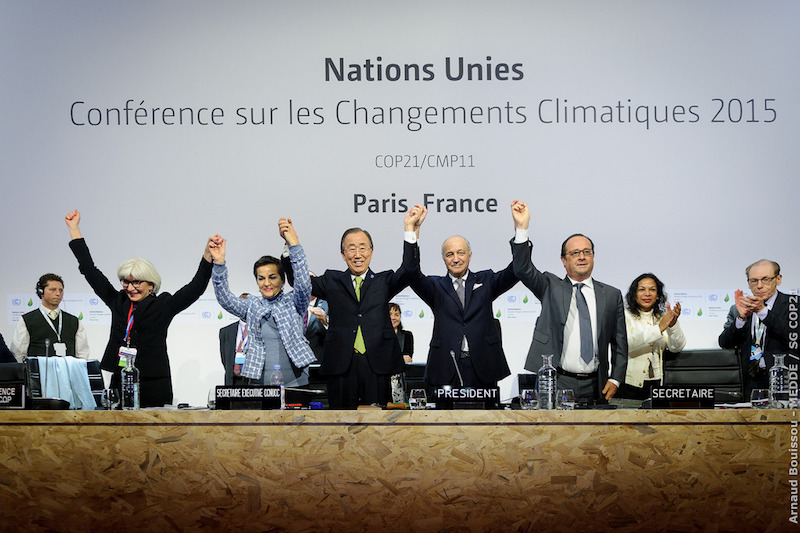The Paris Agreement and the Need for States to Step Up
In an interview with Reuters earlier this year, Gen. Denis Mercier, NATO’s Supreme Allied Commander for Transformation (NATO ACT), reminded us that “climate change poses a global security threat that all countries must fight together.”
It is in this spirit that over 190 states — including the world’s four biggest carbon polluters: China, the United States (US), the European Union (EU), and India — came together at the 21st Conference of the Parties (COP21) to the United Nations Framework Convention on Climate Change (UNFCCC) in Paris in December 2015. At this groundbreaking event, the international community reached an agreement on the need to curb greenhouse gas (GHG) emissions in order to hold “the increase in the global average temperature to well below 2°C above pre-industrial levels.” The Agreement entered into force on November 4, 2016.
In absence of these urgent emission reduction policies, the average global temperature has been estimated to rise between 1.1°C and 6.4°C by the end of this century. Such a rise in temperature would have devastating environmental, political, and social consequences on a global scale.
Following the mixed results of the 1997 Kyoto Protocol, and the failure of the last global attempt to strike a deal in Copenhagen in 2009, the 2016 Paris Agreement was seen as an historic turning point. Unlike the Kyoto Protocol, which only required commitments from 39 developed countries and did not include bigger polluters like China and India, the Paris Agreement requires both developed and developing countries to commit by submitting so-called nationally determined contributions (NDCs) to reduce emissions. At the time of writing, 169 out of 197 Parties to the UNFCCC have both ratified the agreement and submitted their pledges.
On November 7, the Syrian delegation announced its intention to ratify the Paris Agreement at the 23rd Conference of the Parties (COP23) in Bonn, Germany. The announcement, which followed that of Nicaragua, now leaves the United States as the only country not to support the deal. While the Obama administration had played a decisive role in negotiating the Paris Agreement, the new Trump administration announced its intention to withdraw from the Accord this past June and formally notified the United Nations later this past summer.
Still, a US exit would only take effect in four years’ time; according to Article 28 of the Paris Agreement, no country can leave the agreement before November 4, 2020, the day after the next general election. What’s more, despite a reversal of climate change policies at the federal level, the US appears to be making progress in reducing emissions. This is thanks to the strong efforts of state governments (above all California) and a number of major US corporations.
At COP23, Canada, Mexico, and a bipartisan coalition of 15 US Governors known as the US Climate Alliance agreed on a new North American Climate Leadership Dialogue to support reduction policies across North America. They will share their progress at the 2018 Global Climate Action Summit in California next September. Although non-federal action is bearing fruit, a recent study by Kuramochi et al. found that this action alone would take the US only halfway towards meeting its NDC commitment of reducing GHG emissions by 26-28% below its 2005 level in 2025. Federal action is still needed for the country to achieve this goal.
The US federal government’s disengagement has seemingly prompted other parties to take a driving seat in the fight against climate change. By deciding to invest ¥2.5 trillion (US$361 billion) into renewable power energy by 2020, as well as replace gas and diesel cars with cleaner vehicles, China is undoubtedly embracing a more proactive stance in the fight against climate change. However, recent analysis by the Global Carbon Project estimates a rise of between 0.7% and 5.4% in Chinese carbon dioxide emissions this year, predicting further ups and downs on the way to 2020.
The world’s largest coal consumer cannot be expected to instantly cut emissions, but it most likely will in due time. According to the Chinese government, despite this year’s estimated increase in emissions, the targets set in its NDC will largely be met. Yet, although ambitious, these targets, together with the government’s action at the national level, have still been rated as “highly insufficient” by the Climate Action Tracker (CAT).
The same goes for another vocal advocate of climate change mitigation: Canada. Canada’s NDC involves a 30% reduction in GHG emissions from 2005 levels by 2030. To meet this target — also labeled “highly insufficient” by the CAT — the Canadian government should have by now cut emissions by 17%. Instead, the actual emissions cutback amounts to only around 2%. Therefore, according to Angel Gurria, the Secretary-General of the Organization for Economic Co-operation and Development (OECD), the NDC will likely be missed.
This is because Canada is failing to implement the Pan-Canadian Framework on Clean Growth and Climate Change, an overarching strategy document for emission reductions supported by nearly all provinces and territories, except Saskatchewan and Manitoba. According to the CAT, if Canada managed to implement the strategy it would not only achieve, but in all likelihood, exceed its NDC. It is, therefore, imperative that Canada’s provincial and territorial governments start working together on implementing the strategy.
The EU appears compelled to take the lead on climate change policy. In 2009, building on the international commitments made under the Kyoto Protocol, the EU adopted the 2020 Climate and Energy Package in which it pledged to reduce GHG emissions by 20% compared with 1990 levels, increase its use of renewable energies by 20%, and also cut its energy consumption by 20%. Following commitments made under the Paris Agreement, the 28-member bloc now aims to reduce GHG emissions by 40% compared with 1990 levels, increase its use of renewable energies by 27%, and cut its energy consumption by 27% — all by 2030.
By decreasing emissions by 23% in 2016, the EU has already overachieved its 2020 target of a 20% reduction. The organization is also currently in the process of completing a comprehensive legislative framework that will enable it to achieve its 2030 target of a 40% reduction, according to the European Commission. In addition, at COP23 the EU announced its intention to ratify the Doha Amendment, a 2012 amendment to the Kyoto Protocol that imposes new emission reduction targets for the so-called “second commitment period” (2013-2020), by the end of this year. This is proof that the EU is not only living up to its promises but is also committed to leading the fight against climate change. However, it can still be argued, as the team at CAT does, that the 2030 targets to which the EU and its member states committed themselves in their NDCs are inadequate and overall “insufficient” to limit global warming to below 2°C. More ambitious goals for 2030 are therefore, highly desirable.
Climate Change and its Security Dimensions
Why is it of such fundamental importance that countries meet the targets set in their NDCs and keep the inevitable rise in global temperature below 2°C? In short, because climate change is a powerful threat multiplier. By making fundamental resources like water and food scarcer, global warming and its associated implications — such as droughts, floods, storms, decreasing snow and ice cover, and sea level rise — would eventually make political instability and armed conflicts more likely in already unstable and precarious regions of the world.
In particular, climate change’s effects play an important role in migration trends. The International Organization for Migration (IOM) expects climate change to significantly increase the scale of migratory flows, both intranationally and transnationally. An April briefing by the Center for Climate and Security (CCS) showed that in the case of Syria, worsening climate conditions, like drought and food scarcity, exacerbated massive population displacements and migration flows stemming from the now six-year-long civil war.
In 2016, a total of 31.1 million people were newly internally displaced around the world, of which 6.9 million have been displaced due to conflict and violence and 24.2 million because of natural disasters. A year previous, six of the ten countries that produced the most refugees — Afghanistan, Colombia, the Democratic Republic of Congo, South Sudan, Sudan and Syria — were also in the top ten for the most internally displaced people (IDPs), suggesting a strong connection between internal and cross-border displacement. Thus, by further undermining the stability of the Middle East and North Africa (MENA) region, climate change has the potential to deeply affect transatlantic security.
The EU “understands perfectly well…that climate change is also part of security,” stated Federica Mogherini, the High Representative of the Union for Foreign Affairs and Security Policy (HR) and Vice-President of the Commission (VP), at the “Defence and Security Conference Prague: European Vision, European Responsibility” last June.
The EU was one of the first organizations to identify climate change as a threat multiplier, and to develop policy initiatives and strategies to address its strategic and political implications. Already in 2003, the European Security Strategy identified the security implications of climate change and global warming. Later in 2008, in concert with the Commission, Solana presented a report titled “Climate Change and International Security” to the European Council describing climate change as a threat multiplier. More recently in 2016, the EU Global Strategy reaffirmed that climate change is a threat multiplier, and attempted to expand the scope of EU climate diplomacy and integrate it into its foreign and security policy.
Aside from the EU, the North Atlantic Treaty Organization (NATO) has also recognized climate change as a threat multiplier and a specific threat to transatlantic security. Despite not being “the first responder,” the Alliance is increasingly working to respond to climate change and address its security dimensions.
NATO ACT’s Long-Term Military Transformation (LTMT) process aims to “anticipate and prepare for the ambiguous, complex and rapidly-changing future security environment.” The LTMT consists of two parts. Firstly, the Strategic Foresight Analysis (SFA) 2013, which, based on national and international studies, analyzes trends and seeks to identify what the long-term aspects of the future security environment will be in 2030. And, secondly, the Framework for Future Alliance Operations (FFAO), which on the basis of the SFA 2013, elaborates on proposals for transformations that the Alliance will need to undergo, and new skills it will need to develop, in order to be effective in the 2030 security environment.
In a May briefing, the CCS praised NATO for its expanded focus on climate change, pointing out how a number of initiatives are already underway within the Alliance, including strategic planning structures, defence adaptation initiatives, and training. However, the briefing concluded that more needs to be done in order to address climate change in a way that is proportionate to the dangers it poses. Increased cooperation with the EU as well as other organizations and states willing to reform their policies would be a good starting point.
Besides NATO and the EU, Canada also acknowledges climate change as “a risk amplifier for security,” as former Minister of Foreign Affairs Stéphane Dion stated in his address at the conference “Climate Change and Security: Fragile States” in March 2016. His successor, Minister Chrystia Freeland, seems to agree. In her June address on Canada’s foreign policy priorities going forward, she mentioned “the fight against climate change” as a way to “preserve and nurture Canadian prosperity and security”.
Moreover, contrary to the new Commander in Chief’s views on climate change, the national security establishment in Washington D.C. also seems to consider climate change crucial matter of national security. Last year, a bipartisan group of 26 national security and military leaders known as the Climate Security Consensus Project declared that “the effects of climate change present a strategically-significant risk to US national security and international security”. On this basis, in the fall of 2016 the Climate and Security Advisory Group (CSAG), a voluntary, non-partisan group of US-based military, national security, homeland security, intelligence and foreign policy experts sent Mr Trump’s transition team a briefing book. The report recommended that the new US administration “comprehensively address the security risks of climate change at all levels of national security planning, elevate and integrate attention to these risks across the US government, strengthen existing institutions and create new ones for addressing them”.
In fact, climate change poses a serious risk for US military installations, particularly coastal military bases, affecting their military readiness and operational capabilities. The consequences of climate change are already apparent. The Naval Station Norfolk (Virginia), headquarters of the Atlantic fleet, floods several times a year. Three locations of early warning radar infrastructure have also been damaged in Alaska, ultimately requiring them to be moved due to coastal erosion that was not expected to occur until 2030. Moreover, the military base in the Marshall Islands is projected to be underwater within two decades.
President Trump’s top national security leaders, including current Secretary of Defence James Mattis and Director of National Intelligence Dan Coats, also appear to agree that climate change poses significant risks for the country that need to be addressed. In his unpublished written testimony following his confirmation hearing in January, Sec. Mattis vowed to give top priority to the threat climate change poses to US national security.
He appears to be keeping his word. This March, President Trump issued an executive order to repeal all climate-related actions taken by his predecessor President Barack Obama, including a DoD directive to implement the Department’s own “2014 Climate Change Adaptation Roadmap.” However, according to the Military Times, the Pentagon has anything but stopped implementing the roadmap.
Despite the fact that the Republican-controlled Congress does not prioritize climate change, there exists some bipartisan agreement on the security risks that climate change poses. On July 13, 46 Republicans joined forces with 188 Democrats within the House of Representatives to preserve a DoD study on the impacts climate change will have on national security and the military over the next 20 years.
In the House version of the 2018 National Defence Authorization Act (NDAA), the House Armed Services Committee accepted an amendment stating that climate change “is a direct threat to the national security of the United States” and that “military installations must be able to effectively prepare to mitigate climate damage.” In the report accompanying the Senate version of the 2018 NDAA, the Senate Armed Services Committee asked Sec. Mattis to perform a “comprehensive threat assessment” and “implementation master plan on the risks and vulnerabilities to DOD missions and infrastructure associated with climate-related events” by March 2018.
In conclusion, it is unquestionable that climate change poses a threat not only to the environment but also to our security. The EU, NATO, Canada, and several other important parties agree with this assessment. This article clearly emphasizes that these actors can and need to do more in order to avoid the catastrophic consequences that failing the 2°C global target would undoubtedly produce.
The first and crucially important step is for states to achieve the objectives of their NDCs, eventually setting the bar higher when deemed necessary. At the same time, it is extremely important to keep the Americans engaged. The Trump administration may be abandoning the Paris Agreement, but a sizeable portion of the United States is not. It is our collective duty to keep working with all of those Americans who believe that climate change is as serious, if not more serious, a threat to our security than other dangers such as global terrorism.
Photo courtesy of COP 21’s Flickr page. Public domain.
Disclaimer: Any views or opinions expressed in articles are solely those of the authors and do not necessarily represent the views of the NATO Association of Canada.




